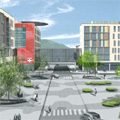Digital hospital
- 22 May 2006
 Linda Davidson
Linda Davidson
The scenario is common but frustrating: a call button is pressed and a nurse arrives to the bedside to find the patient needs something that has fallen on the floor or some other small service that could be delivered by a helpful assistant.
Technological help is at hand to give ward staff a better chance of delivering appropriate assistance to hospital in-patients and ensure patients receive care from the right person at the right time.
A new integrated Nurse Call system is one of the many new features being delivered at St Olav’s Hospital in Trondheim, Norway, an old hospital with a long tradition, now under re-development with many advanced technology features.
Cisco Systems, HP and a Norwegian company called Cardiac are collaborating to provide a set of solutions they describe as being for the digital hospital of the 21st century. The project is led by Telenor – Norway’s equivalent of BT.
Back at the bedside, Nurse Call operates through the patient’s bedside terminal and connects the patient to a call handler who can ask what the patient needs. Just call centre technology, then? No, the system allows the handler to identify the nearest appropriately qualified person to help and alert them to the patient’s needs.
In clinical terms, the system not only matches skills to patient need, but also mobilises the nearest person. At its best the system can save the wrong person walking a long way to find they cannot help and need to call a more appropriately qualified colleague.
In business terms it has the potential to increase efficiency, making best use of the ward staff’s skills.
Immediate access
It is part of a total approach to communications which the partners sum up as medical device integration, converting data to IP everywhere, with immediate access: “Everything over IP and IP over everywhere.”
Nurse Call is part of a total communications technology picture that also includes: IP phones, wireless IP phones, PDAs, RFID tags on equipment, integrated medical devices, patient entertainment terminals and even X-Boxes on the children’s ward. Digital pens are the next step.
The partner companies say that the combined solutions they are implementing will help healthcare professionals to:
- Share patient information quickly and with a high degree of security, making diagnosis and treatment faster and more efficient.
- Track mobile equipment and key assets wirelessly
- Become more responsive by communicating with patients and colleagues wirelessly and in real-time
- Monitor patients remotely, quickly and accurately
- Collaborate more efficiently for effective patient care.
HP’s role includes: acting as systems integrator, providing overall project management, system architecture design, integration with Cardiac’s middleware, security provision and implementation of network and open roaming.
Single infrastructure
Cisco provides a single, converged, intelligent network which supports video, voice and data applications with Cisco’s Clinical Connection Suite. Cardiac will provide Nurse Call integration, alert management, hospital order communications and asset management, based on its Imatis middleware.

"We are building a hospital ICT infrastructure to unlock the benefits of modern healthcare communication for the coming decades," said Arve-Olav Solumsmo, public relations manager of the Hospital Development Project. "Our technology suppliers must not only be state of the art, but state of the future art."
Solumsmo quotes the estimate of staff with patient contact saving 30 to 90 minutes per day by using wireless technology in their work. With a total of 5,000 staff (though not all involved in direct patient care) the scope for improved efficiency would seem to be very significant.
Worth the cost? The ICT infrastructure has cost Norwegian Kr340m (just over £30m) – a sum that represents about 5% of the total budget for the hospital’s redevelopment.
Like its UK counterparts, St Olav’s is conscious of the need to change work patterns to extract benefits from technological investments.
Solumsmo cites research from Hitt and Brynjolfsson showing that companies investing heavily in technology but not changing their work patterns were 4% less productive than those who changed little in either area.
Those that invested heavily in both new technology and new work processes were 5% more productive than those who invested little in either area.
Interestingly, given the current UK experience, electronic patient records are not part of the deal in the hospital’s re-build. Asked about EPR development, Solomsmo replied: “We know it will be electronic sooner or later.”




